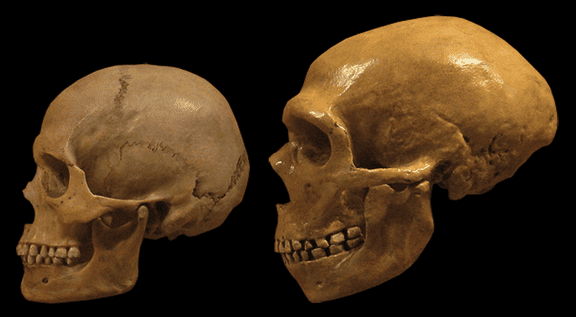New research at the University of Barcelona (UB) found the first genetic evidence that humanity has self-domesticated.

Image credits DrMikeBaxter / Wikipedia.
The team found a network of genes involved in the evolution of human face structure and prosociality in modern humans which is absent in the Neanderthal genome. This suggests that our ancestors preferred to hang out and mate with friendlier and more cooperative companions over less-cooperative, more aggressive ones. In effect, this amounted to selective pressure for prosocial behavior over time, meaning that we domesticated our own species.
Our own best friend
Certain anatomical, cognitive, and behavioral traits of modern humans — chief among them docility and a fragile facial structure — are hallmarks of the domestication process. This led to the idea of human self-domestication being developed all the way back in the 19th century, the team explains. However, we lacked the tools to confirm that this process took place (i.e. that there’s genetic evidence for it).
The study builds on the team’s previous research that looked into genetic similarities between humans and domesticated animals. Now, the team went one step further and looked for genetic evidence for self-domestication in neural crest cells. This is a population of cells that have a major role to play in the early development of vertebrate embryos by differentiating into more specialized cells.
“A mild deficit of neural crest cells has already been hypothesized to be the factor underlying animal domestication,” explains co-author Alejandro Andirkó, a Ph.D. student at the Department of Catalan Philology and General Linguistics of the UB.
“Could it be that humans got a more prosocial cognition and a retracted face relative to other extinct humans in the course of our evolution as a result of changes affecting neural crest cells?”
In order to test their hypothesis, the team focused on Williams syndrome disorder, a human-specific neurodevelopmental disorder caused by a deficit of neural crest cells as the embryo develops. It is characterized by mild to moderate intellectual disability or learning problems, unique personality characteristics, distinctive facial features, and cardiovascular problems.
The researchers used in vitro models of Williams syndrome (stem cells derived from the skin of patients with this syndrome). After poking around, they found that the BAZ1B gene, conveniently located in the region of the genome associated with Williams syndrome, is responsible for controlling the behavior of neural crest cells. If this gene was under-expressed, it led to reduced migration of these cells; higher expression levels led to greater neural crest migration. Then, they compared this gene to its equivalent in samples of archaic (i.e. extinct) and modern (i.e. our ancestors’) human genomes.
“We wanted to understand if neural crest cell genetic networks were affected in human evolution compared to the Neanderthal genomes,” says Cedric Boeckx, ICREA professor at the Department of Catalan Philology and General Linguistics.
Differences in the BAZ1B gene between archaic and modern humans led to a high frequency of mutations in that accumulated over time in modern humans — but not in any of the archaic genomes currently available. The team says this points to BAZ1B as being “an important reason our face is so different when compared with our extinct relatives, the Neanderthals.”
“In the big picture, it provides for the first-time experimental validation of the neural crest-based self-domestication hypothesis,” Boeckx adds.
The paper “Dosage analysis of the 7q11.23 Williams region identifies BAZ1B as a major human gene patterning the modern human face and underlying self-domestication” has been published in the journal Science Advances.









